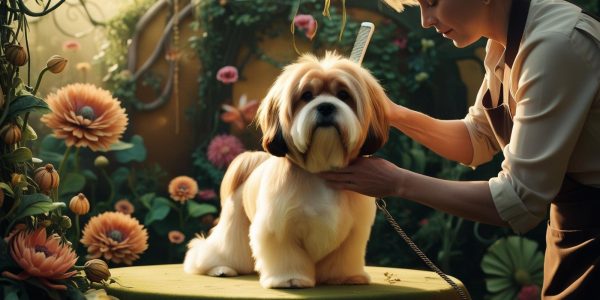
The Complete Expert Guide to Grooming Your Lhasa Apso: Traditional and Modern Care Techniques
The Lhasa Apso, an ancient breed from Tibet, represents one of the most distinctive and challenging breeds when it comes to coat care and grooming. Originally bred as sentinel dogs in Tibetan monasteries, these small but dignified dogs developed their characteristic heavy double coat as protection against the harsh Himalayan climate. In this comprehensive guide, we will explore every aspect of Lhasa Apso grooming, combining traditional wisdom with modern grooming techniques to help you maintain your dog’s coat in optimal condition.
Understanding the Unique Lhasa Apso Coat
Before diving into specific grooming techniques, it’s essential to understand the distinctive characteristics of the Lhasa Apso’s coat. This understanding forms the foundation for all grooming practices and helps explain why certain techniques are particularly important for this breed.
The Lhasa Apso possesses a double coat consisting of a dense, woolly undercoat and a heavy, straight outer coat. The outer coat, which can grow to floor length, has a heavy, straight texture that developed to protect these dogs from both extreme cold and intense sun at high altitudes. This coat structure serves multiple purposes:
The outer coat acts as a protective barrier, keeping moisture away from the skin and helping to regulate body temperature. It grows continuously throughout the dog’s life, similar to human hair, which means it requires regular maintenance to prevent matting and maintain its protective properties.
The undercoat provides insulation and helps regulate body temperature in both hot and cold weather. This dense layer can become severely matted if not properly maintained, leading to skin problems and discomfort for the dog.
Understanding how these two coat layers interact helps explain why specific grooming techniques are necessary. For example, the tendency of the undercoat to mat against the skin while the outer coat appears perfectly fine on the surface makes regular, thorough brushing essential.
Essential Professional Grooming Tools
Successfully grooming a Lhasa Apso requires investing in high-quality tools specifically designed for double-coated breeds with long hair.
Primary Brushing Tools
A pin brush serves as your primary daily grooming tool. When selecting a pin brush, consider these crucial factors:
- The pins should be long enough to reach through both coat layers
- Look for rounded pin tips to prevent skin irritation
- Choose a cushioned pad base for comfort during brushing
- Ensure the pins are sturdy enough to work through dense coat
A slicker brush helps remove loose undercoat and prevent mat formation. Select one with:
- Flexible pins that can work through dense coat
- A comfortable grip for extended grooming sessions
- Different sizes for working on various body areas
- Rounded pin tips to protect the skin
Essential Combing Tools
Metal greyhound combs become indispensable for thorough grooming:
- Wide-toothed sections help with initial detangling
- Fine-toothed sections assist with finishing work
- Extra-long teeth help penetrate the thick double coat
- Smooth, polished teeth prevent coat damage
Professional Cutting Tools
Quality scissors for precise trimming include:
- Straight shears for general cutting and shaping
- Curved shears for working around feet and face
- Thinning shears for blending and reducing bulk
- Small facial scissors for detailed work around eyes
Daily Maintenance Routine
Establishing a consistent daily grooming routine prevents problems before they develop and maintains coat health between professional grooming sessions.
Morning Inspection and Brushing
Begin each day with a thorough inspection of your Lhasa’s coat:
Start by checking common problem areas:
- Behind the ears where matting frequently occurs
- Under the collar where friction causes tangling
- In the armpits where movement creates knots
- Around the sanitary area which requires extra attention
- Behind the legs where friction occurs during walking
Use your pin brush to work through these areas systematically:
- Part the coat down to the skin
- Work in small sections, ensuring complete coverage
- Brush from the skin outward to prevent breaking the coat
- Pay special attention to any areas that feel thick or tangled
Evening Maintenance
Complete another thorough brush-out before bedtime:
- Remove any debris accumulated during the day
- Address any new tangles before they become mats
- Clean the face to prevent eye staining
- Check for any signs of skin issues or irritation
Weekly Deep Grooming Sessions
Beyond daily maintenance, dedicate time each week for more intensive grooming:
Complete Coat Care
Start with a thorough line brushing session:
- Section the coat horizontally
- Work from the skin outward
- Use both pin brush and metal comb
- Check each section thoroughly before moving on
Pay special attention to:
- Areas where the coat appears thicker
- Spots where tangles commonly form
- Regions where the coat changes direction
- Places where accessories or clothing contact the coat
Face and Eye Care
The Lhasa’s facial grooming requires particular attention:
- Clean around the eyes using appropriate eye wipes
- Trim any hair that may be irritating the eyes
- Clean facial folds if present
- Check and clean ear canals to prevent infection
Bathing and Drying Techniques
Proper bathing technique proves crucial for maintaining coat health and preventing problems.
Pre-Bath Preparation
Always complete these steps before bathing:
- Thoroughly brush out any tangles or mats
- Gather all necessary supplies:
- Quality shampoo formulated for long coats
- Conditioner appropriate for double coats
- Multiple clean towels
- High-velocity dryer
- All brushing and combing tools
Bathing Process
Follow these steps for effective bathing:
- Thoroughly wet the coat:
- Use warm water
- Ensure water penetrates both coat layers
- Pay special attention to dense areas
- Work systematically from neck to tail
- Apply shampoo properly:
- Dilute according to instructions
- Work from neck to tail
- Massage thoroughly to reach skin
- Pay special attention to dirty areas
- Use specialized facial products around eyes
- Rinse completely:
- Ensure all soap is removed
- Check multiple times for residue
- Pay special attention to dense areas
- Continue until water runs clear
- Apply conditioner:
- Choose appropriate product for coat type
- Distribute evenly throughout coat
- Allow proper processing time
- Rinse thoroughly to prevent buildup
Drying Techniques
Proper drying prevents skin problems and maintains coat texture:
- Remove excess water:
- Use absorbent towels
- Squeeze rather than rub
- Change towels as needed
- Use high-velocity dryer:
- Start with lower settings
- Keep the nozzle moving
- Work systematically through coat
- Check frequently for complete drying
Professional Grooming Requirements
While regular home maintenance is essential, professional grooming plays a vital role in maintaining proper coat condition and style.
Frequency of Professional Grooming
Schedule professional grooming every 6-8 weeks, considering:
- Your chosen coat length and style
- Your dog’s coat texture and density
- Activity level and lifestyle
- Season and climate
Professional Grooming Process
A complete professional grooming session includes:
- Initial assessment and consultation
- Complete brush-out and detangling
- Bath and conditioning treatment
- Thorough drying and brushing
- Trimming for desired style
- Face and feet detailing
- Final finishing and touch-ups
Seasonal Considerations
Adjust grooming practices based on seasons and activities:
Summer Care
During warmer months:
- Consider shorter styles for comfort
- Increase brushing frequency if swimming
- Monitor for skin issues in hot weather
- Protect from sun exposure
Winter Maintenance
In colder weather:
- Maintain slightly longer coat for warmth
- Watch for static electricity issues
- Monitor for dry skin problems
- Protect paws from salt and ice
Health Monitoring Through Grooming
Regular grooming provides excellent opportunities to monitor health:
Skin Health Indicators
Watch for:
- Redness or irritation
- Dry or flaky patches
- Unusual odors
- Changes in pigmentation
Coat Health Assessment
Monitor for:
- Changes in texture
- Excessive shedding
- Brittle or dry hair
- Dull appearance
Traditional and Modern Styling Options
Traditional Tibetan Style
Understanding traditional grooming helps inform modern practices:
- Floor-length coat maintenance
- Traditional trimming patterns
- Cultural significance of style elements
- Historical grooming techniques
Modern Pet Styles
Contemporary options include:
- Puppy cuts for easy maintenance
- Modified traditional styles
- Sport clips for active dogs
- Custom styling options
Creating a Positive Grooming Experience
Success in grooming depends largely on creating positive associations:
Early Training
Start grooming routines early:
- Begin with short sessions
- Use positive reinforcement
- Gradually introduce new tools
- Build trust through gentle handling
Maintaining Comfort
Keep sessions comfortable:
- Work in a quiet environment
- Use appropriate surfaces
- Take breaks when needed
- Watch for stress signals
Conclusion
Grooming a Lhasa Apso requires dedication, patience, and attention to detail. Understanding their unique coat characteristics and maintaining a consistent grooming routine helps ensure both their appearance and health remain optimal. While the process may seem demanding, the rewards of a well-groomed Lhasa Apso make the effort worthwhile.
Remember that every Lhasa Apso is unique, and you may need to adjust these guidelines based on your dog’s specific coat texture, temperament, and lifestyle needs. Stay committed to your grooming routine, maintain regular professional grooming appointments, and don’t hesitate to seek expert advice when needed. With proper care and attention, your Lhasa Apso can maintain their characteristic appearance while staying healthy and comfortable.
